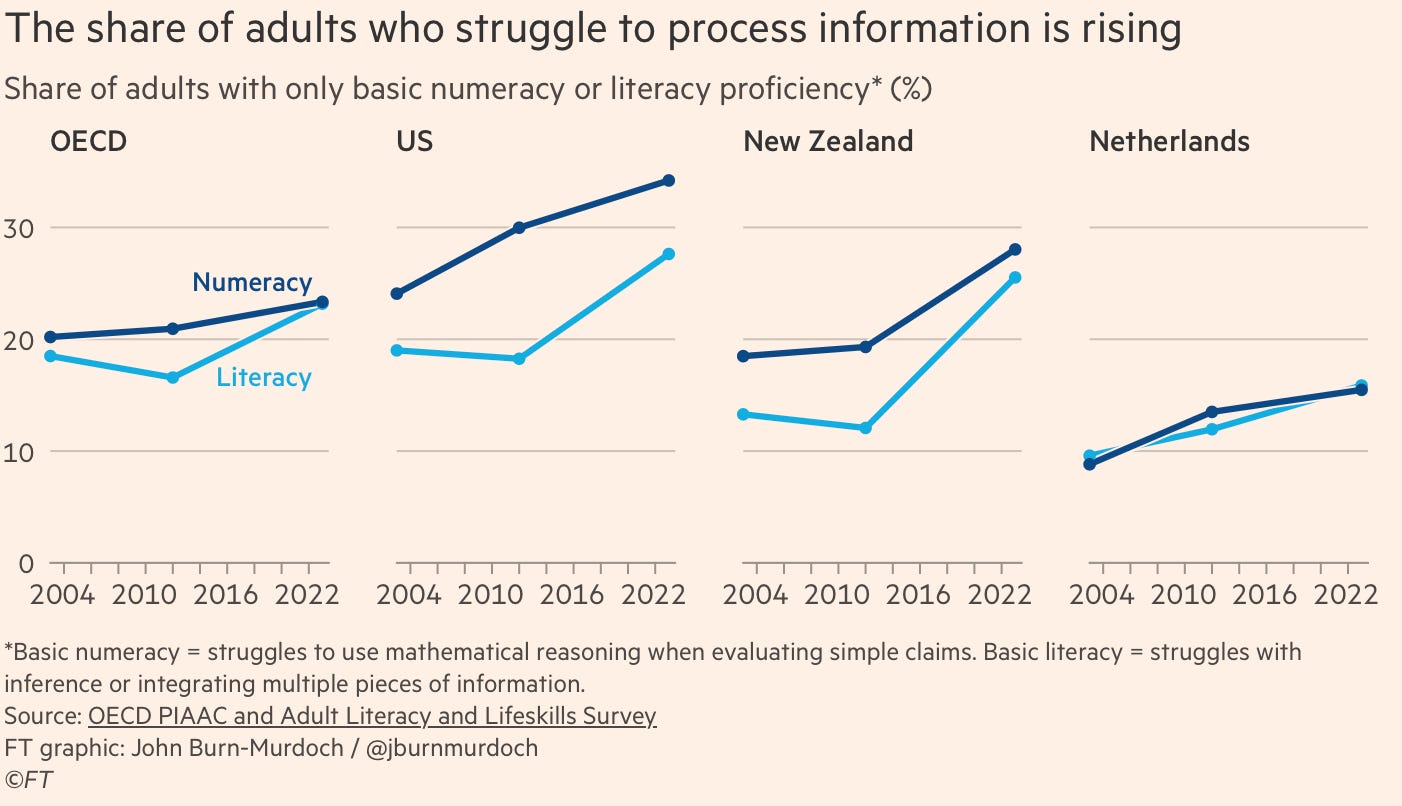
📰 “Have humans passed peak brain power? Data across countries and ages reveal a growing struggle to concentrate, and declining verbal and numerical reasoning,” by John Burn-Murdoch. The Financial Times data guru lays out some disconcerting trends on the decline in human cognition in recent decades as people have moved from more text-based and active reading (books and newspapers) to more visual and passive consumption (screens and phones).
Most discussion about the societal impacts of digital media focuses on the rise of smartphones and social media. But the change in human capacity for focused thought coincides with something more fundamental: a shift in our relationship with information. We have moved from finite web pages to infinite, constantly refreshed feeds and a constant barrage of notifications. We no longer spend as much time actively browsing the web and interacting with people we know but instead are presented with a torrent of content. This represents a move from self-directed behaviour to passive consumption and constant context-switching. Research finds that active, intentional use of digital technologies is often benign or even beneficial. Whereas the behaviours that have taken off in recent years have been shown to affect everything from our ability to process verbal information, to attention, working memory and self-regulation. The good news is that underlying human intellectual capacity is surely undimmed. But outcomes are a function of both potential and execution. For too many of us the digital environment is hampering the latter.
📚 We Hold These Truths: How to Spot the Myths that Are Holding America Back, by Casey Burgat. TLP recently enjoyed publishing a piece from George Washington University professor Casey Burgat, in which he detailed how Congress, through its abdication of power in recent decades, enabled the rise of DOGE. Burgat also recently pulled together a collection of essays from political scholars and operatives for a new book diving into falsehoods and misperceptions people have about America's political system. Among the figures who contributed to the book were former Trump administration official Alyssa Farah Griffin; Democratic operative Adam Jentleson; former Congressmen Steve Israel, Derek Kilmer, and Bill Pascrell; and professors Lilliana Mason and Steve Vladeck, among others.
It's essential reading for anyone who wants a clearer picture of how our government actually works.
⚡️”Eye on the Market: 15th Annual Energy Paper,” by Michael Cembalest. J.P. Morgan’s chairman of investment strategy looks at the current state and speed of the renewable energy transition:
Solar capacity is booming around the world, both utility scale and residential applications, and is often accompanied by energy storage whose costs are declining as well. Yet after $9 trillion globally over the last decade spent on wind, solar, electric vehicles, energy storage, electrified heat and power grids, the renewable transition is still a linear one; the renewable share of final energy consumption is slowly advancing at 0.3 percent–0.6 percent per year. Our 15th annual energy paper covers the speed of the transition, electrification, the changing planet, the high cost of decarbonization in Europe, nuclear power, the Los Angeles fires, Trump 2.0 energy policies, renewable aviation fuels, superconductivity, methane tracking and the continually wilting prospects for the hydrogen economy.
Chock full of data and charts. And yes, Ruy says there will be a quiz!
📰 “Democrats’ crisis: Regulations are choking their support,” by Harry Holzer. TLP friend Holzer argues in The Hill that Democratic overregulation has cost them support from both the business community and new voters who are feeling the effects of costly housing, transportation, and tax policies:
Among other concerns, business leaders were most upset by the strong spike in new economic regulation brought about by Biden—often on labor and environmental issues. Sometimes the regulations even stifled the accomplishments of his own agenda. For instance, Biden’s laudable federal investments in computer chips, infrastructure and green energy were delayed and made more costly by various “Buy American” provisions and labor standards.
But, even without those, they were likely hampered by a variety of existing regulations and practices that make federal construction of any kind very difficult. As an example, after tens of billions of dollars had been invested, only 58 electric vehicle charging stations were completed before his term ended, thereby denying the Democrats the ability to point to these accomplishments and claim credit for them in the 2024 election.
But regulatory barriers on construction at the state and local level might be even more serious, and more harmful to Democrats’ electoral fortunes. It is well-known that there is a steady population flow away from big Blue states, such as California, New York and Illinois, and towards Red states like Texas and Florida. Why? The very high cost of housing—heavily inflated by strict zoning and environmental regulation as well as high taxes—are driving population away, as people vote with their feet.
🎶 Nels Cline Consentrik Quartet. You may be familiar with Clines’ crackerjack guitar work for Wilco or his experimental freakouts in numerous side projects. But this excellent new record on Blue Note finds Cline and friends (Ingrid Laubrock on tenor saxophone, Chris Lightcap on bass, and Tom Rainey on drums) playing traditional jazz in highly novel and enjoyable ways. Cline did all of the compositions for the record and after seeing the quartet play last year in Philly, their new album and live act are not to be missed. Here’s a little punk-style opening followed by intriguing interplay between the four ace musicians on the new song, “The 23.”








Free jazz lives, baby!
Can we acknowedge that DOGE has found a shocking amount of waste? I used to be an environmental voter, meaning I voted mostly democrat because they were better on environmental issues. Its shocking to learn about what has been going on at EPA. Twenty BILLION dollars to climate change. And in the months around the election 200 MILLION rushed out the door to brand new non profits started by dem operatives for climate change education. Please see the RealClear investigation on this subject, its very enlightening.